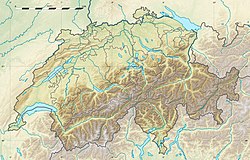| Staffelegg Formation | |
|---|---|
| Stratigraphic range: late Hettangian-early Toarcian ~ | |
 Outcrop of the formation in the Schellen quarry | |
| Type | Geological formation |
| Sub-units | See text |
| Underlies | Opalinus Clay |
| Overlies | Keuper Group |
| Thickness | 20 to 50 m (66 to 164 ft) |
| Lithology | |
| Primary | Siltstone, marl |
| Other | Limestone, sandstone |
| Location | |
| Coordinates | 47°24′N8°36′E / 47.4°N 8.6°E |
| Approximate paleocoordinates | 36°54′N17°24′E / 36.9°N 17.4°E |
| Region | Canton of Aargau |
| Country | Switzerland |
| Extent | Folded Jura |
| Type section | |
| Named for | Staffelegg Pass |
| Named by | Reisdorf et al. |
| Location | Staffelegg |
| Year defined | 2011 |
The Staffelegg Formation (German: Staffelegg-Formation, French: Formation de la Staffelegg, Italian: Formazione della Staffelegg) is a formation of Early Jurassic age (late Hettangian to early Toarcian stages) in the Canton of Aargau of northern Switzerland. The siltstones, marls, limestones and intermittent sandstones of the formation were deposited on the Northern Tethyan Carbonate Platform (NTCP). The Staffelegg Formation has provided fossils of the ichthyosaur Eurhinosaurus longirostris and the ammonite Catacoeloceras raquinianum .

